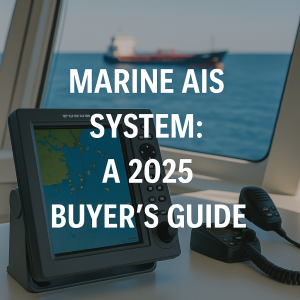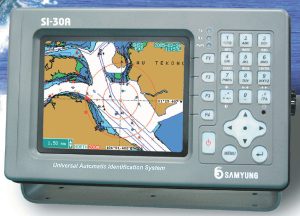 Choosing the right AIS system can make all the difference in maritime safety and navigation. Discover what to look for in a marine AIS system in this expert 2025 guide, packed with real-world insights and global standards.”
Choosing the right AIS system can make all the difference in maritime safety and navigation. Discover what to look for in a marine AIS system in this expert 2025 guide, packed with real-world insights and global standards.”
In today’s maritime world—where waterways are more crowded, voyages are longer, and technology is evolving fast—your vessel’s ability to be seen, heard, and understood has never been more critical. That’s exactly where AIS (Automatic Identification System) comes into play.
But not all AIS units are created equal.
Whether you’re a solo sailor preparing for a transatlantic journey, a commercial skipper navigating tight shipping lanes, or a port authority managing coastal traffic, choosing the right AIS system can dramatically affect your situational awareness, collision avoidance, and compliance with international regulations.
In this comprehensive 2025 guide, we explore what to look for in a marine AIS system—from class types and key features to new tech developments and user-friendly integration—so you can make a confident, well-informed purchase.
Why AIS Systems Matter in Modern Maritime Operations
AIS systems are no longer optional—they’re essential. Since becoming mandatory under SOLAS Chapter V Regulation 19 for vessels over 300 GT on international voyages, AIS has transformed from a commercial-only tool to a near-universal maritime standard.
AIS transponders broadcast vital information such as:
-
Vessel identity (MMSI, name, type)
-
Position (via GPS)
-
Course and speed
-
Navigational status (e.g., anchored, underway, restricted)
According to IMO, over 220,000 commercial and leisure vessels are now equipped with AIS systems worldwide as of late 2024. The number continues to rise, especially in high-traffic areas like the English Channel, Singapore Strait, and Great Lakes.
But even more critically, AIS isn’t just about you being visible—it’s about others being visible to you, especially in poor visibility or tight quarters.
–
Key Technologies and AIS Types Explained
– AIS Class A vs Class B vs Class B+
Understanding AIS classes is the first step in choosing the right system.
Class A
-
Required for commercial vessels >300 GT
-
Transmits at 12.5 watts every 2–10 seconds
-
Includes full voyage-related data (ETA, cargo type)
-
Typically integrated with radar, ECDIS, and bridge systems
-
Ideal for merchant marine, ferries, and large yachts
Class B
-
Designed for smaller recreational boats
-
Transmits at 2 watts every 30 seconds
-
Limited to static and dynamic data (position, speed)
-
Lacks voyage-related info
-
More affordable but offers lower transmission priority
Class B+
-
Newer hybrid version introduced in 2021–2022
-
Transmits at 5 watts every 5–15 seconds
-
Supports SOTDMA protocol (like Class A) for better visibility
-
Popular among ocean-going yachts and small commercial vessels
Note: According to the Royal Institution of Naval Architects, vessels using Class B+ have shown 40% fewer close-call incidents than those using basic Class B in coastal waters with high traffic density (2023 study).
–
– Key Features to Consider in a Modern AIS System
1. Integrated GPS
Modern AIS systems come with high-sensitivity GPS for accurate position tracking. Ensure it’s a 66-channel WAAS-enabled receiver for redundancy and compliance with IMO performance standards.
2. Display or No Display?
Some AIS units are “black box” types that send data to an external chartplotter or MFD. Others include built-in displays for standalone operation. Choose based on your helm layout and available screens.
3. NMEA 0183 & NMEA 2000 Compatibility
Ensure seamless integration with your navigation suite. Most 2025 AIS units support both protocols, but check that your plotter can properly display AIS targets and alarms.
4. AIS Alarms & Collision Avoidance
Advanced units offer CPA/TCPA alarms (Closest Point of Approach / Time to CPA), letting you take proactive action well before a collision risk materializes.
5. Silent Mode / Stealth Function
Useful for fishing boats or sensitive operations, this feature allows your AIS to receive signals without transmitting—helpful in piracy-prone or military zones.
6. Satellite-AIS Support
Some higher-end systems are now integrated with SAT-AIS networks, ensuring long-range visibility even beyond VHF range—ideal for bluewater cruisers.
7. Wi-Fi or Bluetooth
Units like the em-trak B954 or Digital Yacht AIT5000 now feature built-in Wi-Fi for wireless integration with tablets and apps like Navionics or OpenCPN.

Credit: https://www.nauticexpo.it/prod/navis-usa-llc/product-28504-370343.html
Case Studies: Real-World Applications of AIS Systems
Case 1: A Coastal Ferry in British Columbia
BC Ferries equipped their mid-sized vessels with Class A transponders linked to integrated ECDIS systems. In foggy or low-visibility conditions, they rely on AIS target overlays to avoid fishing boats, pleasure crafts, and tug-and-barge traffic.
“Our crew doesn’t just monitor AIS—they make decisions based on it every minute,” says a 2024 safety officer from the fleet.
Case 2: Solo Cruiser in the Caribbean
Marcella, a solo sailor based out of Grenada, installed a Class B+ em-trak B954 AIS before setting off toward Panama. Her goal was to be visible to tankers in deepwater lanes and marinas upon arrival.
“The 5-watt transmission made a real difference. I could see ships adjusting course for me, which never happened before with my older Class B model.”
Challenges and Solutions in AIS Selection and Use
Installation Complexity
Wiring an AIS unit—especially a Class A—requires careful planning. Many units need VHF splitters, GPS antennas, and power routing. Solution: Opt for pre-configured kits and consult professional installers.
Inconsistent Data or Overcrowded Screens
In busy areas, AIS screens can become cluttered. Modern systems solve this with smart filtering algorithms that prioritize closest and fastest-approaching targets.
Cybersecurity
AIS spoofing and data hijacking are rare but increasing threats. Top-tier brands now offer firmware-based encryption and signal authentication.
Future Outlook: AIS in 2030 and Beyond
The future of AIS lies in enhanced automation, machine learning, and satellite fusion.
-
IMO e-Navigation initiatives aim to centralize VTS (Vessel Traffic Services), AIS, radar, and chart overlays into unified platforms.
-
Companies like Inmarsat and Spire Global are leading SAT-AIS integration for merchant shipping lanes.
-
Recreational vessels are increasingly using AIS with collision-avoidance AI, pioneered by startups featured in the Royal Institute of Navigation (2024 Technology Summit).
FAQ: Marine AIS Systems in 2025
1. Is AIS mandatory for all vessels?
No, but it’s required for all SOLAS vessels over 300 GT and passenger ships under IMO regulations. Strongly recommended for recreational boats, especially offshore.
2. Can I install AIS myself?
Yes, many Class B and B+ units are DIY-friendly. However, proper antenna placement and NMEA integration can be tricky—professional installation is advised for Class A.
3. How far can AIS transmit?
Typically 10–20 nautical miles for Class B, and up to 40 nm for Class A under good conditions. Transmission depends on antenna height and power.
4. What’s the difference between AIS receiver and transponder?
A receiver only shows other vessels. A transponder broadcasts your own data too—essential for being seen.
5. Does AIS work over satellite?
Yes, some units support SAT-AIS through services like exactEarth or Inmarsat, but usually with subscription costs.
6. Can AIS help prevent collisions?
Absolutely. With CPA/TCPA alerts and constant updates, AIS complements radar and visual lookout in all weather conditions.
7. Are there any subscription costs for AIS?
No for basic AIS. However, SAT-AIS and advanced data services may involve annual fees.
Conclusion: Be Seen, Stay Safe, Sail Smart
AIS has rapidly become one of the most valuable navigation tools on board any vessel. In 2025, your AIS system isn’t just a passive listener—it’s an active guardian, broadcaster, and data hub.
From choosing the right class (A, B, B+) to ensuring compatibility with your navigation suite, investing in the right AIS means safer journeys, better visibility, and stronger compliance with international maritime law.
So whether you’re sailing the fjords of Norway, crossing to the Caribbean, or maneuvering through Asia’s busiest ports—don’t leave port without it.
Next Step? Explore models from em-trak, Digital Yacht, Garmin, Furuno, and Raymarine, and ensure your vessel is future-ready, fully visible, and firmly in control.
References
-
IMO. (2024). AIS Requirements under SOLAS Chapter V. Retrieved from https://www.imo.org
-
Royal Institution of Naval Architects. (2023). AIS Performance Report in Coastal Waters. https://www.rina.org.uk
-
The Nautical Institute. (2024). e-Navigation & Communication Safety Bulletin. https://www.nautinst.org
-
Inmarsat Maritime. (2025). Satellite-AIS Integration Projects. https://www.inmarsat.com
-
Transport Canada. (2024). Marine Navigation and AIS Use. https://tc.canada.ca
-
em-trak AIS Systems. (2025). Product Guides and Integration Resources. https://www.em-trak.com
-
Digital Yacht. (2025). AIS System Technology Overview. https://www.digitalyachtamerica.com
-
exactEarth. (2024). SAT-AIS and Global Vessel Tracking. https://www.exactearth.com


Thanks